What Do Slugs Eat?
Slugs are not picky about their diet. They’ll eat just about anything they come across as they inch their way across your vegetable garden, flower box and yard. They prefer a few foods over others; when several gather to eat favored vegetation, they can cause rapid destruction.
Slugs eat a diverse range of plants, including the leaves of vegetables, flowers and ornamental plants in your yard. They have a preference for young, tender plants and will eat both the stems and leaves, destroying the plant. A large number of slugs can make short work of a newly planted garden.
Clean-Up Crew
Slugs act as scavengers and eat both dead plants and animals. They help remove dead and decaying leaf debris on the ground, as well as insects, small birds and other animals that they come across. They will also eat fungi, biodegradable trash such as paper, compost and bark. In this capacity, slugs play an important role in the health of their environment.
Some kinds of slugs, such as the leopard slug, hunt down and eat other slugs. You can use these cannibals to your advantage to help rid your yard and garden of other types of slugs. Leopard slugs also eat dead plants, debris and decaying matter.
Popular Attractants
Slugs are drawn to ethylene, which is a chemical released by ripe fruit. This means that just about any type of ripened fruit will attract slugs, such as cherries, raspberries, apples, grapes and strawberries, who will munch on the leaves and the fruit. Beer also releases ethylene, making it a convenient bait for traps that attract slugs searching for food.
There are a few plants that slugs do not like. You can place these in your garden instead of attractive plants to help reduce the number of slugs in your yard. These plants include hardy geraniums, fuchsia, nasturtium, houseleeks, purple foxglove, oyster plant, Japanese anemone, figwort and oriental poppies.
SLUGS
While slugs aren’t insects, they can be major pests for gardeners and homeowners. These slimy creatures can infest a garden and be so pervasive in your lawn that you don’t want to step outside at night. Learn all about slugs and how to eliminate them from your property.
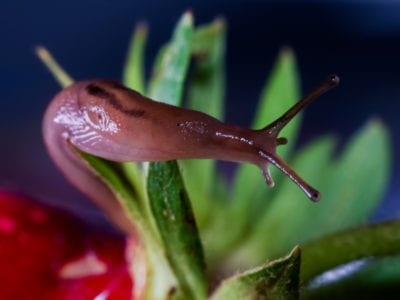
The simplest description is that slugs are snails without shells. Some of these mollusks do, in fact, have a shell, but those that do have internalized the shell and use it to store minerals. Like snails, slugs secrete a film of mucus to protect their delicate skin and to “grease” the surface on which they are traveling.
Slugs are considered a major agricultural pest, and, according to some sources, a single acre of farmland can support nearly a quarter of a million slugs! That means even a small garden is likely to house thousands of them.
What Do Slugs Look Like?
Slugs look like an exceptionally fat worm with two snail-like eyestalks. Naturally, the eyestalks allow for vision, but they also contain olfactory organs as well. Slugs also have two small tentacles under their eyestalks that are used as feelers and taste buds.
Hidden under a slug’s tentacles is the mouth, which opens to release a radula. The radula is a tongue-like organ that has teeth-like protrusions that help it saw through food before ingestion.
In North America, slugs can measure up to 10 inches long.
Most slugs are light brown or gray in color, although the famed banana slug of the Pacific Northwest is often a bright yellow. The skin of a slug is exceptionally moist, and often covered in a thin layer of slimy mucus that helps it retain moisture and protects it from most predators, which dislike the taste.
What Attracts Slugs?
Two key things attract slugs: food and moisture. Unfortunately for gardeners, just about every plant – vegetables and flowers in particular – can serve as food for slugs. They are definitely not picky eaters!
Any area that stays moist during the day or during lengthy hot spells will be attractive to slugs. In particular, they are drawn to the moisture-retaining qualities of mulch, sod, leaves and straw.
Another interesting attractant to slugs are spaces where they can lay their eggs. Gardeners have found that slugs will often lay eggs in areas that have been raked or hoed, while they will avoid soil that has been left smooth by a garden tool. Why? The creases and bumps left by such tools create an ideal incubation area for slugs.
Are Slugs Harmful to Plants?
Yes, slugs can be very destructive garden, farm and landscaping pests. The sheer numbers of slugs in many areas – particularly in irrigated and overly wet locations – can result in massive plant destruction. A slug, which eats many times its body weight each night, simply destroys too much of the plant for it to recover.
We wouldn’t recommend eating a slug – either for you or your pets. First off, the mucus produced by slugs can cause excess drool or induce vomiting. Even worse, in times of stress, slugs are known to produce extra mucus as a deterrent, so your cat or dog would be eating a lot of slug slime.
Further, some slugs are infested with parasitical lungworm, so this parasite can infect your pet. If your pet seems to enjoy eating slugs, ask your veterinarian to provide it with a lungworm vaccine.
Another interesting fact is that slug slime has anesthetic properties – exposure to it will cause numbness. This is another reason why slugs have so few predators – anything that tries to eat a slug will have a numb mouth.
What do Slugs Eat?
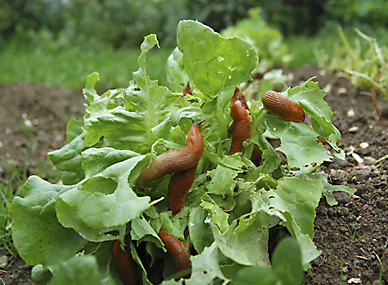
Slugs will eat just about anything. A slug menu can include:
- Cardboard and paper
- Dead animals
- Decomposing plants
- Discarded human food and trash
- Feces
- Flowers
- Fungi
- Leaves
- Pet food
- Seedlings and young plants
- Vegetables
The Slug Life Cycle
Slugs are hermaphrodites, meaning they have both male and female reproductive organs. When two slugs meet, they can mate with one another and fertilize each other’s eggs.
A few days later, both will deposit eggs in a sheltered spot with adequate moisture. From there, the next generation of slugs is born.
Slugs, depending on their species, can live from 1 to 5 years. During the winter, slugs burrow underground to escape freezing temperatures. In fact, it’s said that nearly 95% of the slugs in an area are hidden underground.
A Microscopic Look at Snail Jaws
Have you ever wondered what the inside of a snail’s mouth looks like?
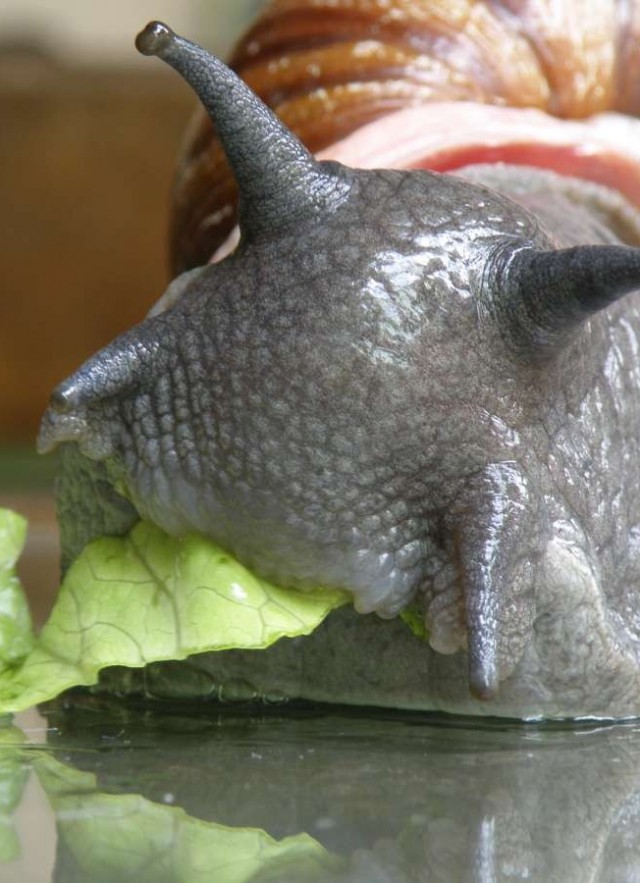
Have you ever wondered what the inside of a snail’s mouth looks like?
The anatomy involved in land snail and slug feeding is fascinating. Well, I’d like to guess that it is more fascinating than you’d expect, if you’ve ever thought about snail and slug feeding in the first place. Snails and slugs have evolved to eat just about everything; they are herbivorous, carnivorous, omnivorous, and detritivorous (eating decaying waste from plants and other animals). There are specialist and generalist species that eat worms, vegetation, rotting vegetation, animal waste, fungus, and other snails.
Thousands of Microsopic Teeth!
Snails and slugs eat with a jaw and a flexible band of thousands of microscopic teeth, called a radula. The radula scrapes up, or rasps, food particles and the jaw cuts off larger pieces of food, like a leaf, to be rasped by the radula. To understand what the single jaw and radular band look like in a terrestrial snail, two Museum interns (from Glendale Community College), Ala Babakhanians and Richard Laguna, photographed a common European Garden Snail (Cornu aspersum) eating a film of cornstarch and water on a piece of glass. This clever method was inspired by the Snail’s Tales blog.
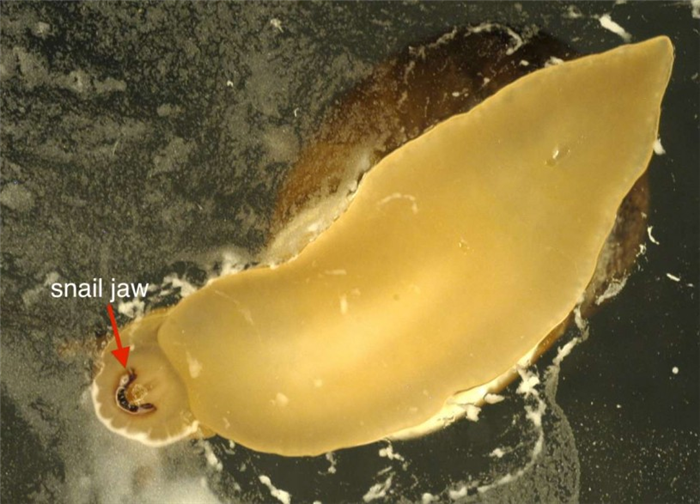
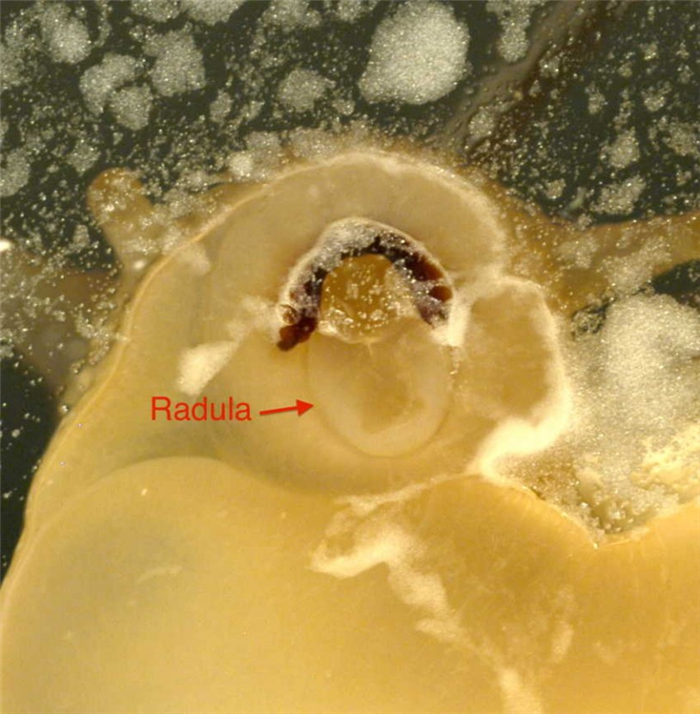
Close up of the open mouth of Cornu aspersum showing the jaw and the pale-colored ribbon of teeth called the radula.
A Close Look at a Slug’s Rasping Radula
The only way to truly appreciate the microscopic teeth of the radula is to look at them under a microscope. To do this, Ole Willadsen, another Glendale Community College intern at NHMLA, dissected out the radula from a non-native slug found on Sunset Boulevard.
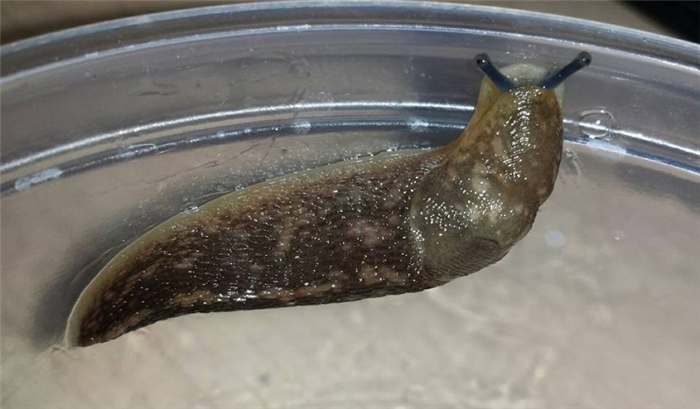
The radula was imaged using the Museum’s scanning electron microscope (SEM), which creates an extremely detailed and highly magnified picture of the specimen examined.
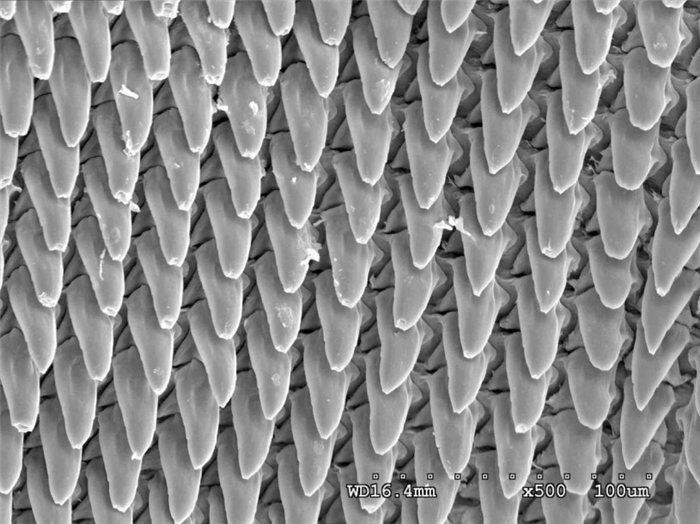
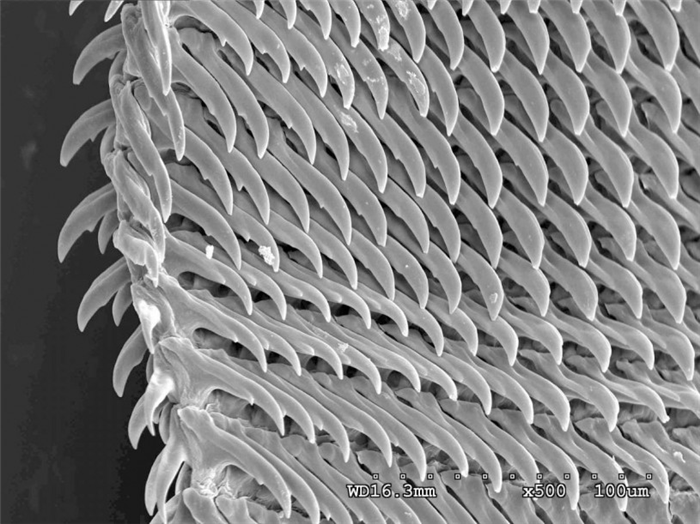
The fascinating feeding anatomy of snails and slugs is also helpful in determining their species identity, if and when that is in question. Since we sometimes don’t know the identity of non-native species we encounter in Los Angeles, the size and shape of their single jaw and thousands of radular teeth can be as informative as they are beautiful.
**Can you hear a snail eating? Yes! Check out Elisabeth Tova Bailey’s book The Sound of a Wild Snail Eating.
If you’d like to be involved in efforts to document and protect L.A.’s biodiversity, check out our Community Science program. Or you can donate to the Urban Nature Research Center.
What do slugs eat?
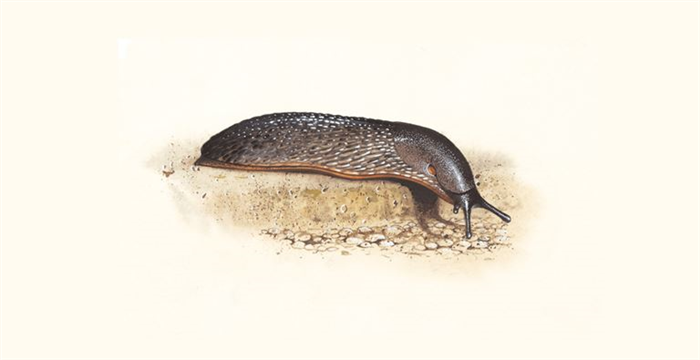
Slug
- Scientific name: Arion hortensis (garden slug) / Limax maximus (great grey slug) / Arion ater (large black slug)
- Type: Invertebrates
Key information
Several species are widespread and common in gardens:
- Garden slug – Arion hortensis – up to 30 mm long, bluish-black with orange underside
- Great grey slug – Limax maximus – up to 200 mm long, pale grey with dark spots
- Large black slug – Arion ater – up to 150 mm long, jet black or orange with a black head.
Slugs are similar to snails, but they have no shell. Instead they have a horny plate concealed under the mantle or saddle. Slugs are active only when the temperature is above 5 degrees C. In dry, cold weather they stay deep in the soil.
Slugs have both male and female reproductive cells (hermaphrodite), but must find a mate to exchange sperm before they can reproduce. They lay batches of gelatinous, watery eggs in moist crevices. The climatic conditions determine how quickly the eggs develop and hatch – the warmer it is, the quicker they develop. It takes about a year for slugs to mature into adults, which can live for about two years.
Slugs can be serious garden pests, eating seedlings, plants and fruit and vegetable crops. However they are eaten by a range of wildlife including hedgehogs, foxes, badgers, many birds, slow worms, violet ground beetles and Devil’s coach horses.
What they eat:
Slugs eat plant leaves, stems and roots, decaying matter and plant debris, fungi and earthworms.
Natural habitats: Bog garden Compost heap Flower border Hedge Herb garden Lawn/grassy area Log pile Meadow area Patio Rock/stone pile Shrub Woodland area
How to Kill Garden Slugs
Now that you know some facts about slugs, you can use them to eliminate the slugs from your garden.
Protect tender plants and seedlings – As tender plants and seedlings are a slug’s favorite food, they are also the most likely to be killed by slugs. Use diatomaceous earth, crushed eggshells or copper wire around plants to create a barrier that slugs cannot cross.
Put out bait – Put out bait such as a pan of beer or an upside down melon rind. The slugs will be attracted to the tender or liquid treat. With beer, they will drown in it. With the melon rind, you can collect the melon rind (and overstuffed slugs) the next morning and dispose of them.
Remove moist areas near the garden – If you have a problem with slugs, you should look at eliminating the areas near your garden where slugs may live. Mulch or containers may be where the slugs are hiding. Remove mulch from near the affected plants and put footers under containers to raise them up off the ground. Clean up boards and weedy areas and regularly turn rocks over to allow the undersides to dry out.
Attract animals that will eat the slugs – Non-poisonous snakes and toads are the best animals to attract to your garden for slug control. These animals exclusively eat small pests and will not damage your plants. Build small woodpiles and put out toad houses to create a home where these animals will feel welcome.
